What to do if regulator will not shut off air outlet on Porter-Cable C2550?
- KKatherine SmithSep 9, 2025
If the regulator won't shut off the air outlet, it likely means the regulator is damaged and needs replacement.
What to do if regulator will not shut off air outlet on Porter-Cable C2550?
If the regulator won't shut off the air outlet, it likely means the regulator is damaged and needs replacement.
What to do if pressure drops on my Porter-Cable Air Compressor when using accessories?
Some pressure drop is normal when using accessories. However, if the pressure drop is excessive, adjust the regulator as instructed in the Operation section. Note that you should adjust the regulated pressure under flow conditions, meaning while the accessory is in use.
Why does my Porter-Cable C2550 make a knocking noise?
A knocking noise could be due to a possible defect in the safety valve (operate manually by pulling on the ring; replace if it still leaks), a defective check valve (contact a Trained Service Technician), loose compressor mounting screws (tighten them), or carbon build-up in the pump (have it checked by a Trained Service Technician).
Why is the air intake restricted on my Porter-Cable C2550 Air Compressor?
A dirty air filter can cause a restricted air intake. Clean or replace the filter. Refer to the Air Filter paragraph in the Maintenance section for instructions.
What causes a squealing sound in my Porter-Cable C2550 Air Compressor?
A squealing sound usually indicates that the compressor pump has no oil. Check the oil level by referring to the Oil-Checking paragraph in the Maintenance section.
Identifies the specific model of the air compressor.
Provides the official website for more information.
Explains the meaning of DANGER, WARNING, and CAUTION symbols.
Warns about chemicals in dust known to cause cancer or reproductive harm.
Details hazards related to flammable vapors, sparks, and overheating.
Discusses conditions leading to tank weakening and explosion.
Covers hazards from compressed air stream and propelled particles.
Outlines dangers of electric shock from improper use or repairs.
Warns against breathing compressor air or sprayed materials.
Alerts to burns from touching hot compressor parts.
Warns about injury from contact with moving components.
Advises on preventing the compressor from falling.
Covers hazards associated with oil leaks during transport.
Emphasizes following instructions for safe operation.
Defines key terms like CFM, SCFM, PSIG, Cut-In/Out Pressure.
Lists detailed technical data for the air compressor model.
Provides steps for attaching the handle to the compressor frame.
Instructions for filling the crankcase with the correct type of oil.
Guidance on choosing a suitable, well-ventilated location.
Details the importance and procedure for proper electrical grounding.
Specifies requirements for using extension cords with the compressor.
Discusses circuit requirements and protection for operation.
Explains the function of controls like On/Auto/Off switch and gauges.
Details components such as dipstick, overload protector, and check valve.
Instructions on safely shutting down the unit.
Essential steps for the initial break-in of the compressor.
Checklist for preparing the compressor before operation.
Step-by-step guide to starting and setting the operating pressure.
Outlines the routine maintenance tasks and their frequency.
Procedure for testing the safety valve for proper function.
Steps for draining condensation from the air tank.
Instructions for checking oil level and changing the oil.
Guidance on inspecting and replacing the air filter.
Explains the function of the thermal overload protector.
Safety precautions to take before performing maintenance or repairs.
Step-by-step instructions for replacing the pressure regulator.
Steps for proper storage to ensure longevity.
Addresses problems with pressure switches and safety valves.
Guides on identifying and fixing air leaks in various components.
Explains normal pressure drops and how to adjust regulator.
Covers causes like excessive use, undersized compressor, or leaks.
Diagnoses issues like tripped overload, pressure switch, or electrical faults.
Addresses potential causes of knocking sounds.
Identifies low oil as a cause for squealing sounds.
Details the warranty duration for different product components.
Outlines steps for processing a warranty claim.
Lists exclusions from the warranty coverage.
| Max Pressure | 150 PSI |
|---|---|
| Power Source | Electric |
| Voltage | 120V |
| Amperage | 15A |
| Pump Type | Oil-Free |
| Tank Capacity | 6 Gallon |
| SCFM @ 90 PSI | 2.6 SCFM |
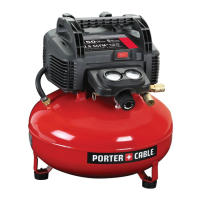
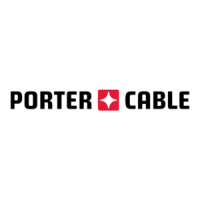

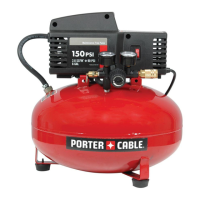

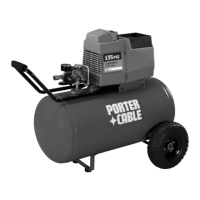
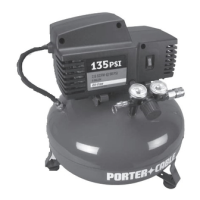

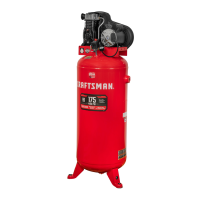
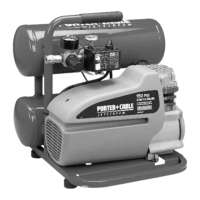
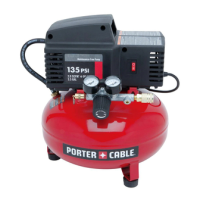
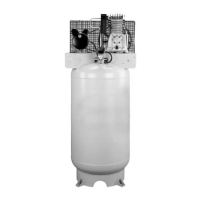
